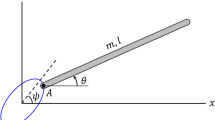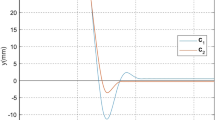Abstract
This paper discusses vibrational stabilization of a class of single-input, two degree-of-freedom mechanical systems. Considering two different control formulations—position-input and force-input—and both open- and closed-loop control, we find that the sets of attainable equilibrium positions for the unactuated coordinate are identical in every case. The subset of positions that are stabilizable, however, depends on the formulation. In general, the set of equilibria that can be stabilized using open-loop force-input is larger than the set that can be stabilized using open-loop position-input. And the use of feedback expands this stabilizable set even further. As examples, this paper presents the dynamic analysis, open- and closed-loop vibrational control, and the mechanics behind the stability of two underactuated systems, the Kapitza pendulum and a one-link horizontal pendulum.












Similar content being viewed by others
References
Artstein, Z.: The pendulum under vibrations revisited. Nonlinearity 34(1), 394–410 (2021)
Baillieul, J.: Stable average motions of mechanical systems subject to periodic forcing. In: Enos, M.J. (ed.) Dynamics and Control of Mechanical Systems: The Falling Cat and Related Problems, pp. 1–23. American Mathematical Society, Providence (1993)
Baillieul, J.: The geometry of controlled mechanical systems. In: Baillieul, J., Willems, J.C. (eds.) Mathematical Control Theory, pp. 322–354. Springer, Berlin (1999)
Baillieul, J.: Averaging methods for force controlled and acceleration controlled Lagrangian systems. In: Proceedings of IEEE Conference on Decision and Control, Sydney, Australia, pp. 1266–1272 (December 2000)
Baillieul, J., Weibel, S.: Scale dependence in the oscillatory control of micromechanisms. In: Proceedings of Conference on Decision and Control, Tampa, FL, pp. 3058–3063 (December 1998)
Bellman, R., Bentsman, J., Meerkov, S.M.: On vibrational stabilizability of nonlinear systems. J. Optim. Theory Appl. 46(4), 421–430 (1985)
Bellman, R.E., Bentsman, J., Meerkov, S.M.: Vibrational control of nonlinear systems: vibrational stabilizability. IEEE Trans. Autom. Control AC–31(8), 710–716 (1986)
Bellman, R.E., Bentsman, J., Meerkov, S.M.: Vibrational control of nonlinear systems: vibrational controllability and transient behavior. IEEE Trans. Autom. Control AC–31(8), 717–724 (1986)
Berg, J.M., Wickramasinghe, I.P.M.: Vibrational control without averaging. Automatica 58, 72–81 (2015)
Bogoliubov, N.N., Mitropolsky, Y.A.: Asymtotic Methods in the Theory of Non-linear Oscillations. Hindustan Publishing Corporation, New Delhi (1961)
Bullo, F.: Averaging and vibrational control of mechanical systems. SIAM J. Control Optim. 41(2), 542–562 (2002)
Bullo, F., Lewis, A.D.: Geometric Control of Mechanical Systems. Texts in Applied Mathematics. Springer, New York (2004)
Butikov, E.I.: On the dynamic stabilization of an inverted pendulum. Am. J. Phys. 69(7), 755–768 (2001)
Butikov, E.I.: An improved criterion for Kapitza’s pendulum stability. J. Phys. A Math. Theor. 44, 295202 (2011)
Cheng, X., Tan, Y., Mareels, I.: Robustness of nonlinear vibrational control systems based on sampling Lyapunov method. In: Proceedings of IEEE American Control Conference, Milwaukee, WI, pp. 4227–4232 (June 2018)
Cheng, X., Tan, Y., Mareels, I.: On robustness analysis of linear vibrational control systems. Automatica 87, 202–209 (2018)
Ciezkowski, M.: Stabilization of pendulum in various inclinations using open-loop control. Acta Mech. Autom. 5(4), 22–28 (2011)
Cinar, A., Deng, J., Meerkov, S.M., Shu, X.: Vibrational control of an exothermic reaction in a CSTR: theory and experiments. AIChE J. 33(3), 353–365 (1987)
Greenwood, D.T.: Principles of Dynamics. Prentice-Hall Inc, Englewood Cliffs (1965)
Grundy, R.E.: The Kapitza equation for the inverted pendulum. Q. J. Mech. Appl. Math. 72(2), 261–272 (2019)
Guckenheimer, J., Holmes, P.: Nonlinear Oscillations, Dynamical Systems, and Bifurcations of Vector Fields, Applied Mathematical Sciences. Springer, New York (1983)
Hong, K.S.: An open-loop control for underactuated manipulators using oscillatory inputs: steering capability of an unactuated joint. IEEE Trans. Control Syst. Technol. 10(3), 469–480 (2002)
Hong, K.S., Lee, K.R., Lee, K.I.: Vibrational control of underactuated mechanical systems: control design through averaging analysis. KSME Int. J. 13(1), 1–10 (1999)
Kabamba, P.T., Meerkov, S.M., Poh, E.K.: Stability robustness in closed loop vibrational control. Int. J. Robust Nonlinear Control 8, 1101–1111 (1998)
Kabamba, P.T., Meerkov, S.M., Poh, E.K.: Pole placement capabilities of vibrational control. IEEE Trans. Autom. Control 43(9), 1256–1261 (1998)
Kapitza, P.L.: Dynamical stability of a pendulum when its point of suspension vibrates. In: ter Haar, D. (ed.) Collected Papers of P. L. Kapitza, vol. 2, pp. 714–725. Pergamon, New York (1965)
Khalil, H.K.: Nonlinear Systems. Prentice-Hall Inc, New Jersey (1996)
Lee, S., Meerkov, S.M., Runolfsson, T.: Vibrational feedback control. In: Proceedings of IFAC 10th Triennial Congress, Munich, Germany, pp. 139–144 (July 1987)
Lee, S., Meerkov, S.M., Runolfsson, T.: Vibrational feedback control: zeros placement capabilities. IEEE Trans. Autom. Control AC–32(7), 604–611 (1987)
Leroquais, W., d’Andrea Novel, B.: Vibrational control of wheeled mobile robots not satisfying ideal velocity constraints: the unicycle case. In: Proceedings of European Control Conference, Brussels, Belgium, pp. 388–393 (July 1997)
Meerkov, S.M.: Vibrational control theory. J. Frankl. Inst. 303(2), 117–128 (1977)
Meerkov, S.M.: Principle of vibrational control: theory and applications. IEEE Trans. Autom. Control AC–25(4), 755–762 (1980)
Meerkov, S.M.: Condition of vibrational stabilizability for a class of nonlinear systems. IEEE Trans. Autom. Control AC–27(2), 485–487 (1982)
Nijmeijer, H., van der Schaft, A.J.: Nonlinear Dynamical Control Systems. Springer, New York (1990)
Nonaka, K., Tamura, K., Baillieul, J.: Open loop vibrational control for cantilevered electromagnetic actuators. In: Proceedings of SICE-ICASE International Joint Conference, Busan, Korea, pp. 61–66 (October 2006)
Runolfsson, T., Meerkov, S.M.: Vibrational-feedback control of decentralized systems: a design algorithm. In: Proceedings of IFAC Workshop on Model Error Concepts and Compensation, Boston, MA, pp. 121–124 (June 1985)
Sahoo, P.K., Chatterjee, S.: High-frequency vibrational control of principal parametric resonance of a nonlinear cantilever beam: theory and experiment. J. Sound Vib. 505, 116138 (2021). https://doi.org/10.1016/j.jsv.2021.116138
Sanders, J.A., Verhulst, F.: Averaging Methods in Nonlinear Dynamical Systems. Applied Mathematical Sciences. Springer, New York (1985)
Seto, D., Baillieul, J.: Control problems in super-articulated mechanical systems. IEEE Trans. Autom. Control 39(12), 2442–2453 (1994)
Stephenson, A.: On induced stability. Philos. Mag. 15, 233–236 (1908)
Suzuki, T., Nonaka, K.: Experiments on semi-closed loop oscillatory control for cantilevered electromagnetic actuators using gradient force model. In: Proceedings of IEEE International Conference on Control Applications, Denver, CO, pp. 1088–1093 (September 2011)
for underactuated mechanical systems using high frequency inputs. ASME J. Dyn. Syst. Meas. Control 137(7), 071004 (2015). https://doi.org/10.1115/1.4029627
Tahmasian, S., Woolsey, C.A.: Flight control of biomimetic air vehicles using vibrational control and averaging. J. Nonlinear Sci. 27(4), 1193–1214 (2017). https://doi.org/10.1007/s00332-016-9334-5
Tahmasian, S., Allen, D.W., Woolsey, C.A.: On averaging and input optimization of high-frequency mechanical control systems. J. Vib. Control 24(5), 937–955 (2018). https://doi.org/10.1177/1077546316655706
Thomsen, J.J.: Some general effects of strong high-frequency excitation: stiffening, biasing and smoothening. J. Sound Vib. 253(4), 807–831 (2002)
Trave, L., Tarras, A.M., Titli, A.: An application of vibrational control to cancel unstable decentralized fixed modes. IEEE Trans. Autom. Control AC–30(3), 283–286 (1985)
Tsakalis, K.S., Ioannou, P.A.: Linear Time-Varying Systems. Prentice-Hall, New Jersey (1993)
Weibel, S., Baillieul, J.: Averaging and energy methods for robust open-loop control of mechanical systems. In: Baillieul, J., Sastry, S.S., Sussmann, H.J. (eds.) Essays on Mathematical Robotics, pp. 203–269. Springer, Berlin (1998)
Weibel, S., Baillieul, J., Kaper, T.J.: Small-amplitude periodic motions of rapidly forced mechanical systems. In: Proceedings of Conference on Decision and Control, New Orleans, LA, pp. 533–539 (December 1995)
Weibel, S., Baillieul, J., Lehman, B.: Equilibria and stability of an n-pendulum forced by rapid oscillations. In: Proceedings of Conference on Decision and Control, San Diego, CA, pp. 1147–1152 (December 1997)
Yabuno, H., Kobayashi, S.: Motion control of a flexible underactuated manipulator using resonance in a flexible active arm. Int. J. Mech. Sci. 174, 105432 (2020). https://doi.org/10.1016/j.ijmecsci.2020.105432
Funding
The authors did not receive support from any organization for the submitted work.
Author information
Authors and Affiliations
Corresponding author
Ethics declarations
Conflict of interest
The authors declare that they have no conflict of interest.
Additional information
Publisher's Note
Springer Nature remains neutral with regard to jurisdictional claims in published maps and institutional affiliations.
Appendix
Appendix
1.1 Averaged potential of a class of Lagrangian systems
The following presents an abstract of the concept of averaged potential based on [2, 50].
Consider an \((n+1)\)-DOF, underactuated mechanical system with the n unactuated generalized coordinates \(\varvec{q}_{\mathrm{u}}=(q_1,\ldots ,q_n)^T\), one actuated coordinate \(q_{\mathrm{a}}\), and Lagrangian
where \(v=v(t)={\dot{q}}_{\mathrm{a}}\) is the control input, \({\mathbb {M}}(\varvec{q}_{\mathrm{u}})\) is the \(n\times n\) inertia matrix, \(\varvec{A}(\varvec{q}_{\mathrm{u}})\) is an \(n\times 1\) inertial coupling vector, and \(V_{\mathrm{a}}(\varvec{q}_{\mathrm{u}};v)\) is called the augmented potential.
Defining the momentum vector \(\varvec{p}=(p_1,\ldots ,p_n)^T\), where \(p_i=\frac{\partial L}{\partial {\dot{q}}_i}\), \(i\in \{1,\ldots ,n\}\), and using the Legendre transformation \(H(\varvec{q}_{\mathrm{u}},\varvec{p};v)=\varvec{p}^T \dot{\varvec{q}}_{\mathrm{u}}-L\), the Hamiltonian corresponding to (A.1) is in the form
Note that since \(v=v(t)\), the Hamiltonian H is not conserved. If v is a T-periodic function, then the Hamiltonian (A.2) is also a T-periodic function and its average, called the averaged Hamiltonian can be determined as
where \(\bar{\varvec{q}}_{\mathrm{u}}\) is the vector of the unactuated coordinates of the averaged dynamics and \(\bar{\varvec{p}}\) is the vector of the average momenta. Replacing H from (A.2) and simplifying, the averaged Hamiltonian \({\bar{H}}\) is determined in the form
where the averaged potential \(V_{\mathrm{A}}\) is
and where the input parameter
and
and
Note that if the velocity function v(t) is zero-mean, then \({\bar{v}}=0\). However, for any function \(v(t) \not \equiv 0\), one finds \(\bar{v^2}\ne 0\).
For the averaged Hamiltonian \({\bar{H}}\), one can write
Therefore, the equilibria and stability of the averaged dynamics, and according to the averaging theorem, the existence and stability of the periodic orbits of the original time-periodic system, can be studied using the averaged potential \(V_{\mathrm{A}}(\bar{\varvec{q}}_{\mathrm{u}};{\bar{v}})\).
1.2 Averaging of mechanical control-affine systems
The following theorem is based on the results developed in Bullo [11], Bullo and Lewis [12], and as presented in Tahmasian et al. [44].
Consider an n-DOF mechanical control-affine system with m inputs. The dynamics of the system can be written in the general form
where \(\varvec{q}=(q_1, \;\ldots , \; q_n)^T\) is the vector of generalized coordinates and \(u_i(t)\) are the inputs. Suppose that \(\varvec{f}(\varvec{q},\dot{\varvec{q}})\) and \(\varvec{g}_i(\varvec{q})\) depend polynomially on their arguments, are twice differentiable in \(\varvec{q}\), and that the components of \(\varvec{f}(\varvec{q},\dot{\varvec{q}})\) are homogeneous in \(\dot{\varvec{q}}\) of degree two and less. Consider high-frequency, high-amplitude inputs \(u_i(t)\), \(i\in \{1,\ldots ,m\}\), in the following form:
where \(\omega \) is the (high) frequency, and \(v_i(t)\) are zero-mean, T-periodic functions.
Using the state vector \(\varvec{x}=(\varvec{q}^T, \; \dot{\varvec{q}}^T)^T\) and the inputs defined in (A.11), system (A.10) can be written in the first-order form
where \(\varvec{Z}(\varvec{x})=\left( \dot{\varvec{q}}^T, \; \varvec{f}^T(\varvec{q},\dot{\varvec{q}})\right) ^T \) is the drift vector field and \(\varvec{Y}_i(\varvec{x})=\left( \varvec{0}_{1\times n}, \; \varvec{g}_i^T(\varvec{q})\right) ^T\) are the input vector fields.
For the inputs (A.11), define scalar parameters \(\kappa _i\), \(\lambda _{ij}\), and \(\mu _{ij}\), for \(i,j\in \{1,\ldots ,m\}\), as follows
and
Also, consider the symmetric product between two input vector fields \(\varvec{Y}_i(\varvec{x})\) and \(\varvec{Y}_j(\varvec{x})\) defined as
where \([\cdot ,\cdot ]\) denotes the Lie bracket of vector fields.
The averaged dynamics of time-periodic system (A.12) then is determined as
with the initial condition \(\bar{\varvec{x}}(0)=\bar{\varvec{x}}_0=\varvec{x}_0+\sum \nolimits _{i=1}^m \kappa _i \varvec{Y}_i(\varvec{x}_0)\), where \(\bar{\varvec{x}}=(\bar{\varvec{q}}^T, \; \dot{\bar{\varvec{q}}}^T)^T\) is the state vector of the averaged dynamics [12, 44].
Rights and permissions
About this article
Cite this article
Tahmasian, S., Woolsey, C.A. On closed-loop vibrational control of underactuated mechanical systems. Nonlinear Dyn 108, 329–347 (2022). https://doi.org/10.1007/s11071-022-07214-y
Received:
Accepted:
Published:
Issue Date:
DOI: https://doi.org/10.1007/s11071-022-07214-y




